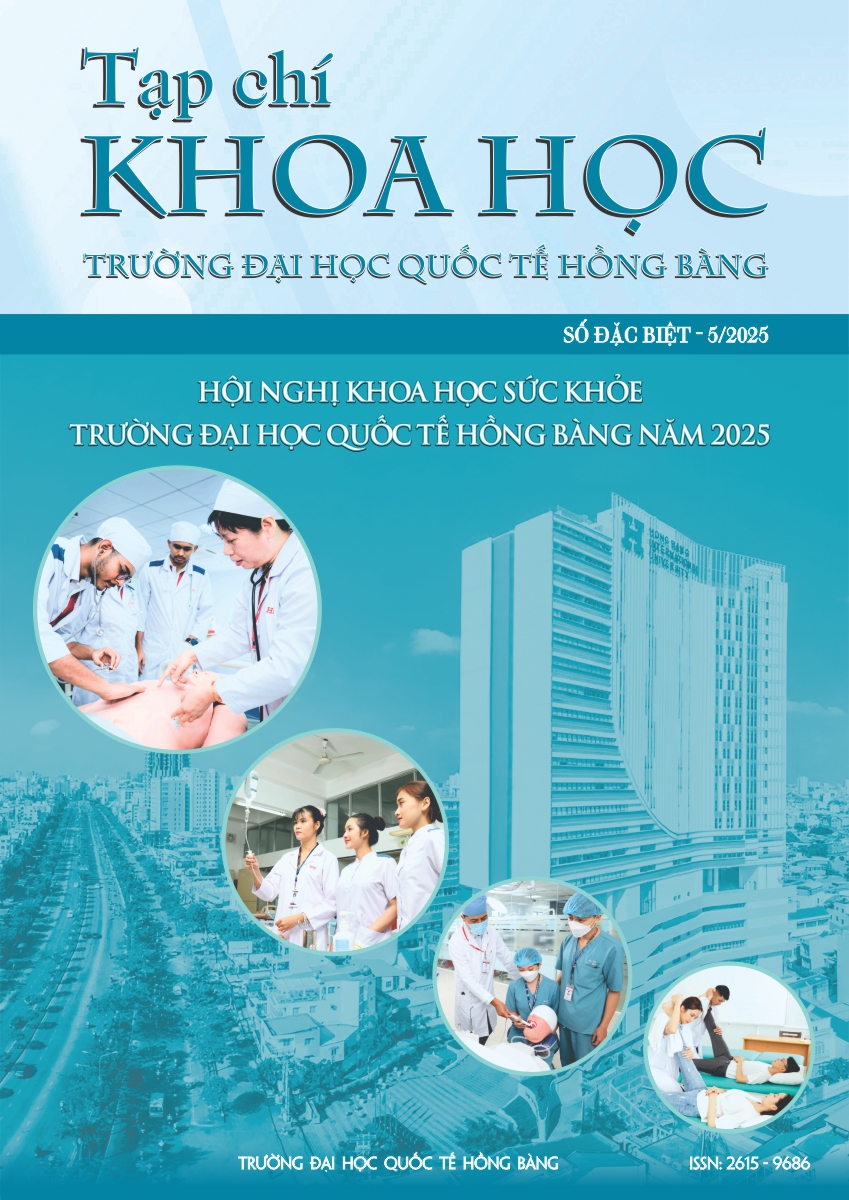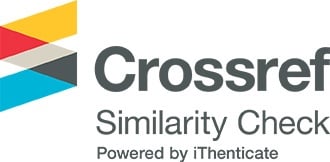HÀM LƯỢNG POLYPHENOL, FLAVONOID VÀ HOẠT TÍNH CHỐNG OXY HOÁ CỦA CAO CHIẾT TỪ CÂY NỌC XOÀI (Struchium sparganophorum (L.) Kuntze.), HỌ CÚC (ASTERACEAE)
Các tác giả
DOI: https://doi.org/10.59294/HIUJS.KHSK.2025.021Từ khóa:
Nọc xoài, hoạt tính chống oxy hoá, polyphenol, flavonoid, coumarinTóm tắt
Đặt vấn đề: Nọc xoài (Struchium sparganophorum (L.) Kuntze.) được sử dụng trong dân gian để sát khuẩn, giảm sưng viêm. Tuy nhiên chưa có nhiều nghiên cứu để cung cấp minh chứng khoa học. Mục tiêu nghiên cứu: Cao chiết tiềm năng từ cây Nọc xoài được xác định dựa trên hàm lượng polyphenol, flavonoid và hoạt tính chống oxy hoá. Phương pháp nghiên cứu: Chiết xuất các cao chiết ethanol 45% và 70% từ lá hoặc toàn cây, tiến hành định tính, định lượng polyphenol tổng và flavonoid toàn phần. Hoạt tính chống oxy hoá của các cao chiết được đánh giá qua thực nghiệm DPPH. Kết quả: Các cao chiết từ lá và toàn cây Nọc xoài có sự hiện diện của flavonoid, alkaloid, saponin, glycosid tim, anthranoid và coumarin. Phân tích sắc đồ lớp mỏng cho các vết có Rf tương tự với acid gallic, quercetin và acid p-coumaric. Cao chiết ethanol 45% từ lá có hàm lượng polyphenol và flavonoid cao nhất, lần lượt là 55.87 mg GAE/1 g cao và 26.62 mg QE/1 g cao. Cao chiết ethanol 45% từ lá thể hiện hoạt tính chống oxy hóa tốt nhất so với các mẫu cao còn lại (IC50 = 85.76 µg/mL). Kết luận: Cao chiết ethanol 45% từ lá Nọc xoài có tiềm năng chống oxy hóa nhiều triển vọng cho các nghiên cứu tiếp về tác dụng dược lý theo hướng ngăn ngừa bệnh lý liên quan đến tổn thương oxy hóa.
Abstract
Background: Struchium sparganophorum (L.) Kuntze., commonly known as "Nọc xoài", belongs to the Asteraceae family and is traditionally used in folk medicine for its antiseptic, anti-inflammatory, and wound-healing properties. However, there is a lack of scientific studies to validate these traditional uses. Objectives: This study aimed to identify the most potential extract of S. sparganophorum based on total phenolic and flavonoid contents, as well as antioxidant activity. Methods: Ethanolic extracts (45% and 70%) were prepared from both leaves and the whole plant. Phytochemical screening was conducted to qualitatively assess the presence of bioactive compounds. Total phenolic and flavonoid contents were quantified using spectrophotometric methods. Antioxidant activity was evaluated using the DPPH radical scavenging assay. Results: Phytochemical analysis revealed the presence of flavonoids, alkaloids, saponins, cardiac glycosides, anthranoids, and coumarins in all extracts. Thin-layer chromatography indicated spots with Rf values corresponding to gallic acid, quercetin, and p-coumaric acid. Among the extracts, the 45% ethanolic extract from leaves exhibited the highest total phenolic and flavonoid contents at 55.87 mg GAE/g extract and 26.62 mg QE/g extract, respectively. The 45% ethanolic extract from leaves also demonstrated the best antioxidant activity (IC50 = 85.76 µg/mL), as compared to other extracts. Conclusion: The 45% ethanolic leaf extract of S. sparganophorum demonstrated the most promising antioxidant potential for further pharmacological investigation in the prevention of oxidative stress-related diseases.
Tài liệu tham khảo
[1] D.P. Xu , Y. Li, X. Meng, T. Zhou, Y. Zhou, J. Zheng, J.J. Zhang, H.B. Li, “Natural antioxidants in foods and medicinal plants: Extraction, assessment and resources”, International Journal of Molecular Sciences, vol. 18, no. 1, p. 96, 2017.
DOI: https://doi.org/10.3390/ijms18010096[2] I. G. Munteanu and C. Apetrei, “Analytical methods used in determining antioxidant activity: A review,” International Journal of Molecular Sciences, vol. 22, no. 7, p. 3380, 2021.
DOI: https://doi.org/10.3390/ijms22073380[3] https://tracuuduoclieu.vn/Struchium-sparganophorum.
[4] Bộ Y tế, “Dược điển Việt Nam V”, 2018.
[5] T. Hùng, “Phương pháp nghiên cứu dược liệu,” Bộ môn Dược liệu - Khoa Dược: Trường Đại học Y Dược TP. Hồ Chí Minh, tr. 25-49, 2014.
[6] Đại học Y Dược Thành phố Hồ Chí Minh - Bộ môn Dược liệu, “Giáo trình Thực tập Dược liệu”, 2022.
[7] M. Lefahal, N. Zaabat, R. Ayad, et al., “In Vitro Assessment of Total Phenolic and Flavonoid Contents, Antioxidant and Photoprotective Activities of Crude Methanolic Extract of Aerial Parts of Capnophyllum peregrinum (L.) Lange (Apiaceae) Growing in Algeria”, Medicines (Basel), vol. 5, no. 2, pp. 26, 2018.
[8] M. Lefahal, N. Zaabat, R. Ayad, E. H. Makhloufi, L. Djarri, M. Benahmed, H. Laouer, G. Nieto, S. Akkal, “In vitro assessment of total phenolic and flavonoid contents, antioxidant and photoprotective activities of crude methanolic extract of aerial parts of Capnophyllum peregrinum (L.) Lange (Apiaceae) growing in Algeria,” Medicines (Basel, Switzerland), vol. 5, no. 2, p. 26, 2018.
DOI: https://doi.org/10.3390/medicines5020026[9] V. Burman, H. Kanaujia, K. Lehari, Aastha, N. P. Singh, and Vaishali, “Characterization of phenolic compounds of turmeric using TLC,” Journal of Pharmacognosy and Phytochemistry, vol. SP2, pp. 994-998, 2019.
[10] A. Dóka, “TLC and HPLC Screening of p-Coumaric Acid, trans-Resveratrol, and Pterostilbene in Bacterial Cultures, Food Supplements, and Wine”, Journal of Planar Chromatography - Modern TLC, vol. 25, no. 3, pp. 224-229, 2012.
DOI: https://doi.org/10.1556/JPC.25.2012.3.11[11] I. Urquiaga and F. Leighton, “Plant Polyphenol Antioxidants and Oxidative Stress”, Biological Research, vol. 33, no. 2, pp. 55-64, 2000.
DOI: https://doi.org/10.4067/S0716-97602000000200004[12] M. Traykova and I. Kostova, “Coumarin Derivatives and Oxidative Stress”, International Journal of Pharmacology, vol. 1, pp. 29-32, 2005.
DOI: https://doi.org/10.3923/ijp.2005.29.32[13] P. Chaudhary, P. Janmeda, A. O. Docea, B. Yeskaliyeva, A. F. A. Razis, B. Modu, D. Calina, J. S.-Rad, “Oxidative stress, free radicals and antioxidants: potential crosstalk in the pathophysiology of human diseases”, Frontiers in Chemistry, Sec. Medicinal and Pharmaceutical Chemistry, vol. 11, 2023. doi: 10.3389/fchem.2023.1158198.
DOI: https://doi.org/10.3389/fchem.2023.1158198[14] S. G. Tumilaar, A. Hardianto, H. Dohi, D. Kurnia, “Comprehensive Review of Free Radicals, Oxidative Stress, and Antioxidants: Overview, Clinical Applications, Global Perspectives, Future Directions, and Mechanisms of Antioxidant Activity of Flavonoid Compounds”, Journal of Chemistry, 2024. https://doi.org/10.1155/2024/5594386.
DOI: https://doi.org/10.1155/2024/5594386[15] G. Oboh, A. J. Akinyemi, A. O. Ademiluyi, “Antioxidant Properties and Inhibitory Effect of Ethanolic Extract of Struchium sparganophora (Ewuro Odo) Leaf on α - Amylase and α - Glucosidase Activities”, African Journal of Traditional, Complementary and Alternative Medicines, vol. 9, no. 3, pp. 342-349, 2012.
DOI: https://doi.org/10.4314/ajtcam.v9i3.7[16] S. O. Salawu, D. M. Sanni, A. A. Akindahunsi, “HPLC/DAD/MS phenolic profile, antioxidant activities and inhibitory action of Struchium sparganophora (Linn) and Telfairia occidentalis (Hook. F) Against low density lipoprotein oxidation”, African Journal of Food Science and Technology, vol. 4, no. 1, pp. 1-8, 2013.
Tải xuống
Tải xuống: 458











